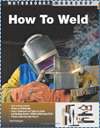 Library Muse
Library Muse
A book Report by Jake Snyder
 Based on the front covers, these books are equivalent. Both promise the MG Owner with Peace Everlasting from the Rust Monster. And both will get you there, just by different routes. But the routes are quite different. Based on the front covers, these books are equivalent. Both promise the MG Owner with Peace Everlasting from the Rust Monster. And both will get you there, just by different routes. But the routes are quite different.

 How to Weld (HTW),
How to Weld (HTW),
Todd Bridigum, Motorbooks, Minneapolis, 2008.
Cost: $15 - $25 depending on vendor.
|
 Assuming that the average MG Owner/Driver is preoccupied with driving her/his MG (T, A, B, C, etc), the question of how to compromise between the rust-free summer months (mostly) and rust from salt that is the curse of a longer driving season is always there. It is easy to understand how someone who has spent hundreds of hours on bodywork (or the equivalent number of dollars) will wish to avoid future predicaments with the same car. Pretty much, this is the same as saying, “Use it AND lose it” if driving continues into the salt season. Part of the answer for some may be that “If I use it the way I want to it will rust and I will fix it”. These books provide the technical solution to that choice. Assuming that the average MG Owner/Driver is preoccupied with driving her/his MG (T, A, B, C, etc), the question of how to compromise between the rust-free summer months (mostly) and rust from salt that is the curse of a longer driving season is always there. It is easy to understand how someone who has spent hundreds of hours on bodywork (or the equivalent number of dollars) will wish to avoid future predicaments with the same car. Pretty much, this is the same as saying, “Use it AND lose it” if driving continues into the salt season. Part of the answer for some may be that “If I use it the way I want to it will rust and I will fix it”. These books provide the technical solution to that choice.

 Welders Handbook (WH),
Welders Handbook (WH),
A Guide to Plasma Cutting, Oxyacetylene, ARC, MIG and TIG Welding
Richard Finch,
HP Books, New York, 2007.
Cost: $15 - $25 depending on vendor.
|
 The truism that “It’s a lot easier if you know how” applies to welding as for many other endeavors. Assuming that the MG Owner/Driver is committed to rust over comfort, choosing which of these books fill individual needs depends on the level of welding skill she/he currently meets. Assuming, however, that the MG Owner/Driver has a ‘project car’ which starts, runs and stops and that there are places on the floorboards where driver and passenger may safely rest their feet, and that the reason to consider welding has become one of keeping the car on the road, both these are your books. The purpose of this book report is to help you choose on which one to read first. The truism that “It’s a lot easier if you know how” applies to welding as for many other endeavors. Assuming that the MG Owner/Driver is committed to rust over comfort, choosing which of these books fill individual needs depends on the level of welding skill she/he currently meets. Assuming, however, that the MG Owner/Driver has a ‘project car’ which starts, runs and stops and that there are places on the floorboards where driver and passenger may safely rest their feet, and that the reason to consider welding has become one of keeping the car on the road, both these are your books. The purpose of this book report is to help you choose on which one to read first.
 The big difference in the books shows up by page 2 of chapter 1. HTW, the more massive book at just over 200 pages, presents the reader with ‘weld certification’ as the first step. WH on page 2 of chapter 1 shows a welder in full safety gear making a repair to a Cup Car. Take the hint: if you want to know a little more immediately about welding on cars, read WH first. If you are reading HTW, put a book mark on Chart 1-1 of page 9. This is chart that gives the professional-to-hobbyist welder terms for the processes. For example ‘GMAW’ = ‘MIG’. WH on the other hand usually refers to processes in the terms we usually hear: MIG, TIG, oxyacetylene. The big difference in the books shows up by page 2 of chapter 1. HTW, the more massive book at just over 200 pages, presents the reader with ‘weld certification’ as the first step. WH on page 2 of chapter 1 shows a welder in full safety gear making a repair to a Cup Car. Take the hint: if you want to know a little more immediately about welding on cars, read WH first. If you are reading HTW, put a book mark on Chart 1-1 of page 9. This is chart that gives the professional-to-hobbyist welder terms for the processes. For example ‘GMAW’ = ‘MIG’. WH on the other hand usually refers to processes in the terms we usually hear: MIG, TIG, oxyacetylene.
 HTW has a more complete section on shop safety and covers shop tools in greater depth. The coverage of ‘GMAW’ (also known as MIG, see above) is about 25 pages long. It covers multiple welding machines and shows parts of the gun and wire feed systems. The practice problems with real welding photos is part of every of the technique sections. HTW has a more complete section on shop safety and covers shop tools in greater depth. The coverage of ‘GMAW’ (also known as MIG, see above) is about 25 pages long. It covers multiple welding machines and shows parts of the gun and wire feed systems. The practice problems with real welding photos is part of every of the technique sections.
 Neither book tells you exactly what you have to do to perform rust repair on a step-by-step basis. In that sense, neither is a true rust repair ‘how-to’ book. There may be disagreement with the shielding gas compositions for MIG welding and the choice of the feed wire size is not particularly clear. But that information is available elsewhere from fellow MG owners, magazine articles and live instruction. The basic welding information is clear in both books and each complements the other. Neither book tells you exactly what you have to do to perform rust repair on a step-by-step basis. In that sense, neither is a true rust repair ‘how-to’ book. There may be disagreement with the shielding gas compositions for MIG welding and the choice of the feed wire size is not particularly clear. But that information is available elsewhere from fellow MG owners, magazine articles and live instruction. The basic welding information is clear in both books and each complements the other.
 WH gets going more quickly with constant reference to cars in photos. There is a short section at the very end about welding certification. The presentation of the welding material is more interesting and there is a higher chance of finishing this book than is the case for HTW. Rather than extensive practice examples, the end of the book has many potentially useful projects to make from jack stands to a trailer which most likely could be modified to use to bring home the next MG project car. WH gets going more quickly with constant reference to cars in photos. There is a short section at the very end about welding certification. The presentation of the welding material is more interesting and there is a higher chance of finishing this book than is the case for HTW. Rather than extensive practice examples, the end of the book has many potentially useful projects to make from jack stands to a trailer which most likely could be modified to use to bring home the next MG project car.
|
|